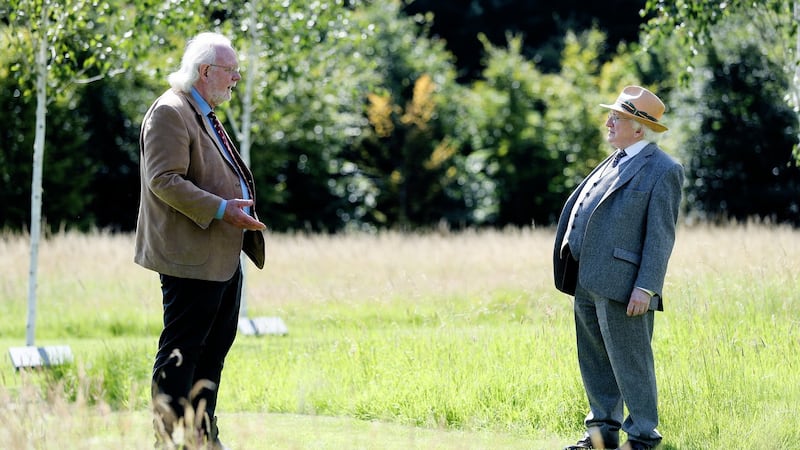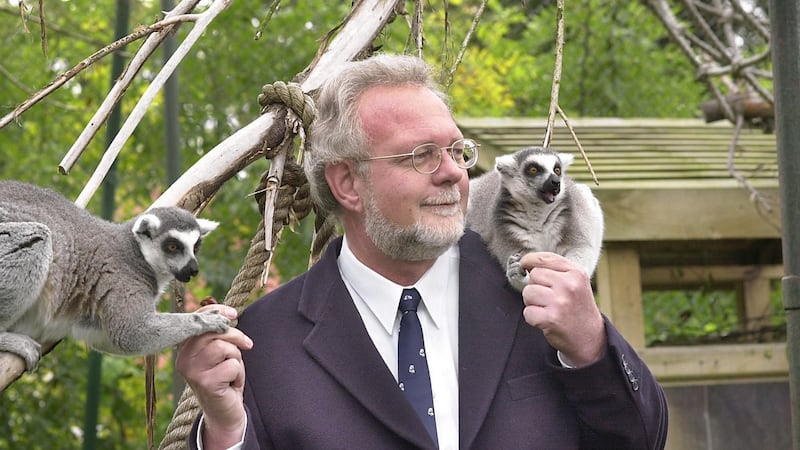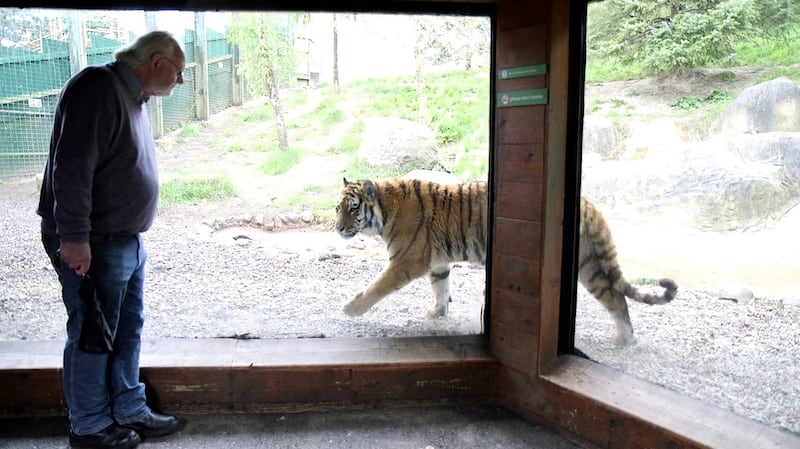When Leo Oosterweghel walked through the doors of a small zoo in his home town around 50km west of Amsterdam at the age of 15 to start his first summer job he didn’t think for a moment he was setting out on a trail that would take him across Africa and Australia and end up in Ireland, where he would be instrumental in saving an institution from extinction.
The director of Dublin Zoo is retiring this weekend after 19 years in charge of what has become one of Ireland’s most popular tourist destinations, and although he leaves at a time of unparalleled crisis, for the zoo, the country and the entire world, he can go knowing he is leaving the zoo in a much better place – from a financial and conservation perspective – than he found it when he became director in October 2001.
“I was looking after vultures and eagles and condors even though I was just 15,” Oosterweghel says in his small office near the zoo’s main entrance as he recalls his first job. “I loved it and the people who owned the zoo – it’s closed now – are still my friends and they’re in their 80s.”
I spent a lot of time with insects
As he talks he glances at the poster above his desk. It reads: “Education is not the filling of a pail but the lighting of a fire.” It is a line widely – and wrongly – attributed to WB Yeats and is most likely a paraphrasing of Plutarch, who wrote, according to most translations, “The mind is not a vessel to be filled, but a fire to be kindled”.
Oosterweghel admits to not knowing who said it but whatever its provenance he has no doubt about its essential truth. “We shoudn’t have to shove facts down people’s throats, we should always aim to inspire them.”
Then he – sort of – shoves a fact down my throat, although I can see why. He insists on writing down the name of the zoo, Wassenaar Zoo, where it all started for him and sliding it across the table to me just in case I get the spelling wrong. “They would be very upset if you spelled it wrong,” he tells me.
After his formative experience in Wassenaar Zoo, the course of his life was all but decided. “I went to the national history museum in Leiden for four years after finishing school,” he says in the pronounced Dutch accent he has never lost despite leaving the country of his birth more than 40 years ago. “It was immersion work, and I spent a lot of time with insects,” he continues.
From Leiden, he travelled around Africa, working with animals considerably larger than the insects he started out with, before being appointed director of Melbourne Zoo.
The voice at the other end said 'Hello, this is Bertie'. I thought it was someone playing a practical joke on me
“In 2001 I got a phone call from someone who heard I was planning to leave Melbourne and they said Dublin was looking for a director and would I be interested. Of course I said yes. And when I arrived in Dublin I found an optimistic place. Land had been given to us by our neighbour, the president, and the African Plains were on the way with a grant from the OPW.”
Bertie Ahern was taoiseach and Oosterweghel describes him as a huge supporter of the zoo and a great motivator. “He really wanted the zoo to succeed.”
He recalls a nightmare scenario which unfolded when a visitor was bitten by an animal not long after he arrived. With the story understandably making headlines, some more alarming than others, he received a call from an unknown number. “When I answered, the voice at the other end said ‘Hello, this is Bertie’. I thought it was someone playing a practical joke on me.”
But it wasn’t, Ahern wanted to check-in to make sure Oosterweghel was doing okay and coping with the stress of the crisis and to see if he needed any help.
Ahern also provided State funding to the tune of €20 million so the new director could reinvigorate the zoo. Haughton House, built in 1898, was restored; the Forest Trail leading to the elephants was developed and those elephants were given a new home while all manner of other animal-centric enhancements were rolled out.

“2010 was the turning point,” he says. “Up until then, I would get letters from people saying ‘This is a terrible zoo’.”
But then the tone of the letters changed and people started to write to him to praise the zoo. Word spread that things were happening at the zoo and visitor numbers started to climb, and climb fast. When he became the director, just under 600,000 came through the turnstiles each year. Last year the number stood at 1.2 million with almost all the visitors local. “Tourists from overseas don’t tend to want to come to zoos,” he says, almost mystified as to why they wouldn’t.
When he talks about the zoo and the animals, the passion in his voice is easy to detect, as is the sense of responsibility he knows comes with the job. “My phone is never turned off, it hasn’t been turned off for 20 years. Imagine if something happened to the animals and I could not be contacted, that would be unforgivable. The involvement and the commitment is total.”
He is proud of what he has achieved and how the quality of life of the animals has been improved while “an amazing experience for people” has been developed. He is also proud the numbers have stacked up with profits made every year for more than a decade. Last year the zoo generated a profit of €3.5 million and Oosterweghel points out that all the profits have gone back into the enterprise.
The zoo is not only Oosterweghel’s place of work, it is also his home. He has lived in what must be one of the most desirable locations in the country, right at the heart of the zoo since he arrived. He hears the wolves howling at night and the lions roaring in the late evening. If there is a commotion in the elephant house, he is the first to hear it. And in the early morning he often wakes to the sound of gibbons singing.
We walk past the house where he and his partner Colette Kinsella, who he met when she came to interview him for a radio project, live with three rescue cats and a cane toad. The toad was found in a suitcase in Dublin Airport, so he adopted it. “This is the Garden of Eden,” he says gesturing expansively towards the overgrown garden in full Mediterranean bloom. “It is the result of minimum maintenance, he adds. Given its lushness, that seems unlikely.

He points to a chimney where herring gulls nest. “I can hear exactly what they are saying and the opposite of that is true too, they can hear exactly what we are saying.”
It is when the zoo closes to the public that it comes into its own for him. “It is so private. I walk around, I see things no-one else sees and I see how the animals behave. From my bedroom window I can hear all the sounds, it’s magical.”
We walk and talk and stop briefly at the macaques to marvel at how cute the little primates are. Then two of them start, well, humping. “I didn’t teach them that,” he says. We move on.
He looks out over an overgrown area the orangutans now call home and says that when he arrived it was a flat piece of land. “There was just a climbing frame decorated with car tyres. Now the inspiration comes from the wild and we make sure there are places for the animals to hide. We want to give them a choice so they are empowered to get away from the human primates if that’s what they want to do. When we design we always say ‘let’s listen to the animals, to what they want’. The zoo is a stage, isn’t it, but it is a stage inspired by the animals”.
Sometimes I visit zoos and I don't tell people I work in a zoo because I am so upset and I am so embarrassed and what I see is so wrong
Dublin Zoo is almost entirely unrecognisable from the one conceived in the Rotunda Hospital in 1830 when a group of medics and scientists established the Zoological Society of Ireland. Their motives were not as animal-centric or altruistic as Oosterweghel’s and its purpose was to entertain wealthy Dubliners, with the entrance fee set at six pence. Commoners were allowed in on Sundays if they paid a penny.
The zoo’s other aim was to provide access to animal corpses for doctors not mad on grave-robbing out in Glasnevin Cemetery. Once animals – specially the primates – had outlived their usefulness as spectacles, their cadavers were much sought after for research purposes.
We are worlds away from that now but Oosterweghel knows there are many people who are of the view that the very concept of a zoo is morally wrong. He has heard many of the arguments many times over many years. “This is a modern zoo where we genuinely care about the animals but sometimes I visit zoos and I shut up about my job, I don’t tell people I work in a zoo because I am so upset and I am so embarrassed and what I see is so wrong.”
He admits there was a time when Dublin Zoo was no better. “It was a vulgar curiosity and animals were a commodity and you could replace them by buying a replacement.” He recognises that animals were too often forced to live in conditions which were absolutely alien to their instinct. Elephants were confined in small spaces as couples when in fact, “herd is everything” for them.
In 2006 the zoo was home to an elephant house designed in the 1950s. It was no longer fit for purpose so he had it replaced. One of the key elements of the new elephant house was one of the simplest. Sand. In most zoos, elephant houses have concrete floors which are easier to clean and to maintain which makes them the preferred option. At least for the humans. The elephants are not so keen.
Concrete floors in zoos are one reason many people believe elephants like to sleep standing up. They don’t, they just can’t sleep comfortably lying on concrete. So Dublin Zoo put down sand and now the elephants sleep for seven or eight hours a day. And are much happier for it.
The way zoos used to manage animals was based on suppression and violence but today in Dublin Zoo the main focus is on animal welfare and while they are in a confined space, the quality of the lives of the animals is vastly improved on what it once might have been and what it still is in many other parts of the world.
When it comes to conservation he says the zoo is “trying really, really hard. There are 400 Sumatra tigers left in the wild and the same number bred in captivity. The habitat where they are supposed to be is being destroyed and there is poaching going on.”

As to the future of the zoo he says the next big challenge is “surviving. Surviving this year, surviving the start of next year. We can live on our fat and hopefully by March 2021 we will be back to some kind of normality.”
When asked how the job of the new director will differ from the one he took on when he arrived, he says it is more about the science and the conservation now than it was then but adds that the new director can still expect “the same amount of worry about rubbish bins and accounts and complaints and reporting to the board”.
He and Kinsella are planning to move to the Netherlands and he admits it will difficult to leave his life in Dublin behind. “I would like to be 10 years younger and there is so much more to do but it is time for the next generation.”










